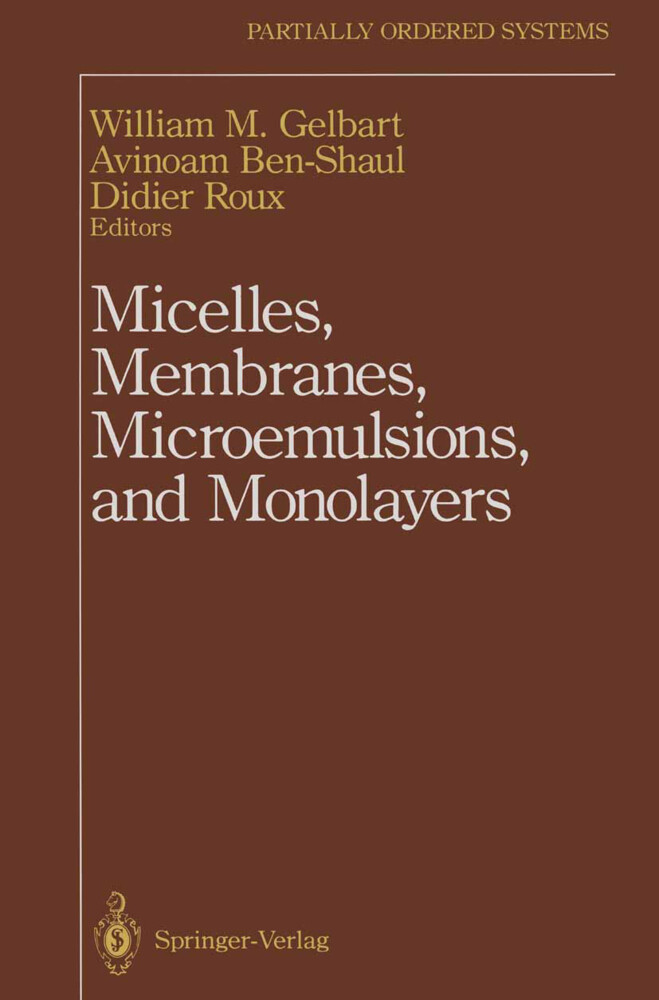Bücher versandkostenfrei*100 Tage RückgaberechtAbholung in der Wunschfiliale

Zustellung: Sa, 08.02. - Di, 11.02.
Versand in 2 Tagen
VersandkostenfreiBestellen & in Filiale abholen:
Over the last decades, the study of surfactants (detergents, for example) has been profoundly changed by ideas and techniques from physics, chemistry, and materials science. Among these are: self assembly; critical phenomena, scaling, and renormalization; high-resolution scattering, and magnetic resonance spectroscopy. This book represents the first systematic account of these new developments, providing both a general introduction to the subject as well as a review of recent developments. The book will be a very useful tool for the biophysist, biochemist or physical chemist working in the field of surfactants.
Inhaltsverzeichnis
1 Statistical Thermodynamics of Amphiphile Self-Assembly: Structure and Phase Transitions in Micellar Solutions. - 1. 1 Introduction. - 1. 2 Amphiphile Self-Assembly in Dilute Solutions. - 1. 3 Molecular Organization of Aggregates. - 1. 4 Interaction Effects in Dilute Solution and Beyond. - 1. 5 Concluding Discussion. - 2 Micellar Growth, Flexibility and Polymorphism in Dilute Solutions. - 2. 1 Introduction. - 2. 2 Globule to Rod Transformation. - 2. 3 Polymerlike Behavior. - 2. 4 Bidimensional Aggregation. - 2. 5 The Physical Basis of Micellar Polymorphism. - 2. 6 Connection with Microemulsions. - 3 Micellar Liquid Crystals. - 3. 1 Introduction. - 3. 2 Nomenclature. - 3. 3 Preparation of Stable Nematic Phases. - 3. 4 Factors Governing Size and Shape of Micelles in Concentrated Solutions. - 3. 5 Experimental Characterization of Nematic Phases. - 3. 6 Phase Transitions in Micellar Solutions. - 3. 7 Conclusions. - 4 Geometrical Foundation of Mesomorphic Polymorphism. - 4. 1 Introduction. - 4. 2 Mesophases as Structures of Films. - 4. 3 Frustration, Curved Spaces and Disclinations. - 4. 4 The Periodic System of Parallel Films. - 4. 5 Comments. - 4. 6 Conclusion. - 4. 7 Appendix. - 5 Contents Lamellar Phases: Effect of Fluctuations (Theory). - 5. 1 Introduction. - 5. 2 Model of Isolated Membranes. - 5. 3 Membranes in Interaction. - 5. 4 Conclusion. - 5. 5 Appendix. - 6 Lyotropic Lamellar L? Phases. - 6. 1 Introduction. - 6. 2 Phase Diagrams. - 6. 3 Membranes and Smectic Properties. - 6. 4 Static Scattering Studies of Lyotropic Lamellar Phases. . . - 6. 5 Dynamic Light Scattering. - 6. 6 Conclusion. - 7 The Structure of Microemulsions: Experiments. - 7. 1 Introduction. - 7. 2 The Interfacial Film of Surfactant. - 7. 3 Dilute Microemulsions. - 7. 4 Structure of Concentrated Microemulsions. - 7. 5 Conclusions. - 7. 6 Appendix: X-ray and Neutron Scattering. - 8Lattice Theories of Microemulsions. - 8. 1 Introduction: Aims of a Lattice Theory of Microemulsions. - 8. 2 The Lattice Formulation. - 8. 3 Some Results of the Three Component Model. - 8. 4 Some Results of Other Lattice Models. - 8. 5 Comparison with Phenomenological Models. - 9 Fluctuating Interfaces and the Structure of Microemulsions. - 9. 1 Introduction. - 9. 2 Experimental Observations and Theoretical Models. - 9. 3 Fluctuation of Microemulsions. - 9. 4 Lamellar and Random/Bicontinuous Systems. - 9. 5 Outstanding Problems. - 10 Interfacial Tension: Theory and Experiment. - 10. 1 Introduction. - 10. 2 Experimental Techniques and Data Analysis. - 10. 3 The Bending Elasticity of Monolayers: Experimental Results. - 10. 4 Experimental Study of Low Surface Tensions in Winsor Equilibrium. - 10. 5 Structure of the Oil Microemulsion and the Water Microemulsion Interfaces in Winsor Equilibria. - 11 Critical Behavior of Surfactant Solutions. - 11. 1 Introduction. - 11. 2 Structure and Interactions. - 11. 3 Critical Phenomena. - 11. 4 Conclusion. - 12 Structures and Phase Transitions in Langmuir Monolayers. - 12. 1 Introduction. - 12. 2 The Experimental Situation. - 12. 3 Equilibrium Theories of Monolayers. - 12. 4 Dynamical Properties of Amphiphilic Monolayers. - 12. 5 Conclusions and Future Prospects.
Produktdetails
Erscheinungsdatum
15. November 2011
Sprache
englisch
Auflage
Softcover reprint of the original 1st ed. 1994
Seitenanzahl
628
Reihe
Partially Ordered Systems
Herausgegeben von
Avinoam Ben-Shaul, William M. Gelbart, Didier Roux
Verlag/Hersteller
Produktart
kartoniert
Abbildungen
XVI, 608 p.
Gewicht
937 g
Größe (L/B/H)
235/155/34 mm
Sonstiges
Paperback
ISBN
9781461383918
Entdecken Sie mehr
Bewertungen
0 Bewertungen
Es wurden noch keine Bewertungen abgegeben. Schreiben Sie die erste Bewertung zu "Micelles, Membranes, Microemulsions, and Monolayers" und helfen Sie damit anderen bei der Kaufentscheidung.









